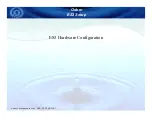
STRATABOX
™
Operations And Maintenance Manual
Beam Width
The beam width of a transducer is described as the width of the main lobe of a transmit pattern. The
width is usually measured between the -3 dB points on either side of the beam pattern. Shown in Figure
1-2 is a transmit beam pattern for a 125 kHz transducer. The shape of the transducer beam pattern is a
result of the transducer design. An array of ceramic elements, or a single ceramic element, emits sound at
given frequency. The spacing of the elements and the frequency being used can control the shape of the
beam pattern. At the center of the beam pattern is the main lobe of the transducer, with a width of 7
degrees (centered at zero degrees). The -3 dB point is shown as a dashed line on the graph. The side
lobes of this transducer are the smaller lobes, approximately 18 dB below the level of the main lobe.
Figure 1-2 Acoustic Beam Pattern
The width of a beam is important for calculating how small an object the system can detect. If two
objects fall within the main beam the object will appear as one object when it is received by the system.
Thus, a narrow beam width is required for navigational echo sounders so it is capable of discriminating
small objects.
The size of the transducer sidelobes (smaller beams off to the side of the main lobe) is important in
determining how the system will behave on steep slopes. On steep slopes, transmitted acoustic energy
from the side lobes will be received first and reveal a signal that looks like the actual bottom. In reality,
the bottom is directly below the ship, and as seen by the main lobe, is much deeper. For this reason, it is
important to select a transducer which has reduced sidelobes.
INTRODUCTION 1-6
©
2006 SyQwest Incorporated
















































